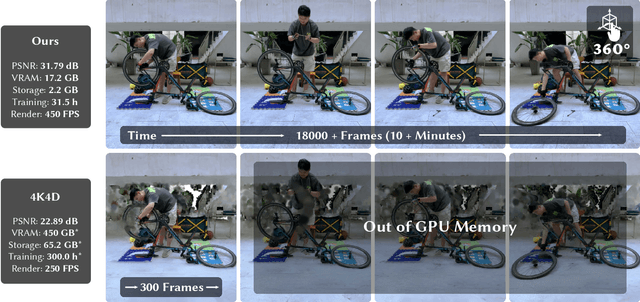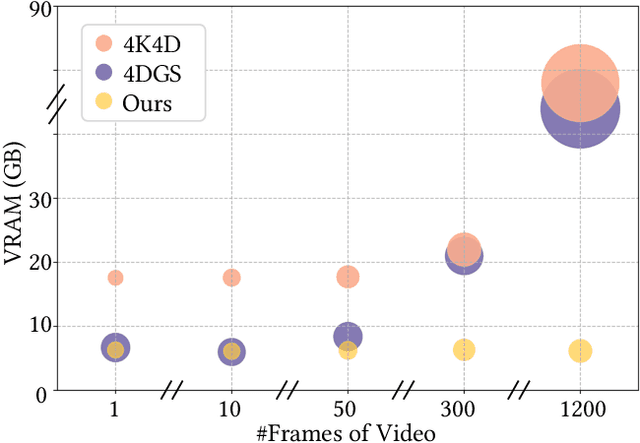Yinghao Xu
Mixture of Contexts for Long Video Generation
Aug 28, 2025Abstract:Long video generation is fundamentally a long context memory problem: models must retain and retrieve salient events across a long range without collapsing or drifting. However, scaling diffusion transformers to generate long-context videos is fundamentally limited by the quadratic cost of self-attention, which makes memory and computation intractable and difficult to optimize for long sequences. We recast long-context video generation as an internal information retrieval task and propose a simple, learnable sparse attention routing module, Mixture of Contexts (MoC), as an effective long-term memory retrieval engine. In MoC, each query dynamically selects a few informative chunks plus mandatory anchors (caption, local windows) to attend to, with causal routing that prevents loop closures. As we scale the data and gradually sparsify the routing, the model allocates compute to salient history, preserving identities, actions, and scenes over minutes of content. Efficiency follows as a byproduct of retrieval (near-linear scaling), which enables practical training and synthesis, and the emergence of memory and consistency at the scale of minutes.
Video World Models with Long-term Spatial Memory
Jun 05, 2025



Abstract:Emerging world models autoregressively generate video frames in response to actions, such as camera movements and text prompts, among other control signals. Due to limited temporal context window sizes, these models often struggle to maintain scene consistency during revisits, leading to severe forgetting of previously generated environments. Inspired by the mechanisms of human memory, we introduce a novel framework to enhancing long-term consistency of video world models through a geometry-grounded long-term spatial memory. Our framework includes mechanisms to store and retrieve information from the long-term spatial memory and we curate custom datasets to train and evaluate world models with explicitly stored 3D memory mechanisms. Our evaluations show improved quality, consistency, and context length compared to relevant baselines, paving the way towards long-term consistent world generation.
Interspatial Attention for Efficient 4D Human Video Generation
May 21, 2025



Abstract:Generating photorealistic videos of digital humans in a controllable manner is crucial for a plethora of applications. Existing approaches either build on methods that employ template-based 3D representations or emerging video generation models but suffer from poor quality or limited consistency and identity preservation when generating individual or multiple digital humans. In this paper, we introduce a new interspatial attention (ISA) mechanism as a scalable building block for modern diffusion transformer (DiT)--based video generation models. ISA is a new type of cross attention that uses relative positional encodings tailored for the generation of human videos. Leveraging a custom-developed video variation autoencoder, we train a latent ISA-based diffusion model on a large corpus of video data. Our model achieves state-of-the-art performance for 4D human video synthesis, demonstrating remarkable motion consistency and identity preservation while providing precise control of the camera and body poses. Our code and model are publicly released at https://dsaurus.github.io/isa4d/.
CameraCtrl II: Dynamic Scene Exploration via Camera-controlled Video Diffusion Models
Mar 13, 2025Abstract:This paper introduces CameraCtrl II, a framework that enables large-scale dynamic scene exploration through a camera-controlled video diffusion model. Previous camera-conditioned video generative models suffer from diminished video dynamics and limited range of viewpoints when generating videos with large camera movement. We take an approach that progressively expands the generation of dynamic scenes -- first enhancing dynamic content within individual video clip, then extending this capability to create seamless explorations across broad viewpoint ranges. Specifically, we construct a dataset featuring a large degree of dynamics with camera parameter annotations for training while designing a lightweight camera injection module and training scheme to preserve dynamics of the pretrained models. Building on these improved single-clip techniques, we enable extended scene exploration by allowing users to iteratively specify camera trajectories for generating coherent video sequences. Experiments across diverse scenarios demonstrate that CameraCtrl Ii enables camera-controlled dynamic scene synthesis with substantially wider spatial exploration than previous approaches.
GroomLight: Hybrid Inverse Rendering for Relightable Human Hair Appearance Modeling
Mar 13, 2025Abstract:We present GroomLight, a novel method for relightable hair appearance modeling from multi-view images. Existing hair capture methods struggle to balance photorealistic rendering with relighting capabilities. Analytical material models, while physically grounded, often fail to fully capture appearance details. Conversely, neural rendering approaches excel at view synthesis but generalize poorly to novel lighting conditions. GroomLight addresses this challenge by combining the strengths of both paradigms. It employs an extended hair BSDF model to capture primary light transport and a light-aware residual model to reconstruct the remaining details. We further propose a hybrid inverse rendering pipeline to optimize both components, enabling high-fidelity relighting, view synthesis, and material editing. Extensive evaluations on real-world hair data demonstrate state-of-the-art performance of our method.
FLARE: Feed-forward Geometry, Appearance and Camera Estimation from Uncalibrated Sparse Views
Feb 19, 2025Abstract:We present FLARE, a feed-forward model designed to infer high-quality camera poses and 3D geometry from uncalibrated sparse-view images (i.e., as few as 2-8 inputs), which is a challenging yet practical setting in real-world applications. Our solution features a cascaded learning paradigm with camera pose serving as the critical bridge, recognizing its essential role in mapping 3D structures onto 2D image planes. Concretely, FLARE starts with camera pose estimation, whose results condition the subsequent learning of geometric structure and appearance, optimized through the objectives of geometry reconstruction and novel-view synthesis. Utilizing large-scale public datasets for training, our method delivers state-of-the-art performance in the tasks of pose estimation, geometry reconstruction, and novel view synthesis, while maintaining the inference efficiency (i.e., less than 0.5 seconds). The project page and code can be found at: https://zhanghe3z.github.io/FLARE/
RelightVid: Temporal-Consistent Diffusion Model for Video Relighting
Jan 27, 2025Abstract:Diffusion models have demonstrated remarkable success in image generation and editing, with recent advancements enabling albedo-preserving image relighting. However, applying these models to video relighting remains challenging due to the lack of paired video relighting datasets and the high demands for output fidelity and temporal consistency, further complicated by the inherent randomness of diffusion models. To address these challenges, we introduce RelightVid, a flexible framework for video relighting that can accept background video, text prompts, or environment maps as relighting conditions. Trained on in-the-wild videos with carefully designed illumination augmentations and rendered videos under extreme dynamic lighting, RelightVid achieves arbitrary video relighting with high temporal consistency without intrinsic decomposition while preserving the illumination priors of its image backbone.
Edicho: Consistent Image Editing in the Wild
Dec 30, 2024Abstract:As a verified need, consistent editing across in-the-wild images remains a technical challenge arising from various unmanageable factors, like object poses, lighting conditions, and photography environments. Edicho steps in with a training-free solution based on diffusion models, featuring a fundamental design principle of using explicit image correspondence to direct editing. Specifically, the key components include an attention manipulation module and a carefully refined classifier-free guidance (CFG) denoising strategy, both of which take into account the pre-estimated correspondence. Such an inference-time algorithm enjoys a plug-and-play nature and is compatible to most diffusion-based editing methods, such as ControlNet and BrushNet. Extensive results demonstrate the efficacy of Edicho in consistent cross-image editing under diverse settings. We will release the code to facilitate future studies.
Representing Long Volumetric Video with Temporal Gaussian Hierarchy
Dec 12, 2024



Abstract:This paper aims to address the challenge of reconstructing long volumetric videos from multi-view RGB videos. Recent dynamic view synthesis methods leverage powerful 4D representations, like feature grids or point cloud sequences, to achieve high-quality rendering results. However, they are typically limited to short (1~2s) video clips and often suffer from large memory footprints when dealing with longer videos. To solve this issue, we propose a novel 4D representation, named Temporal Gaussian Hierarchy, to compactly model long volumetric videos. Our key observation is that there are generally various degrees of temporal redundancy in dynamic scenes, which consist of areas changing at different speeds. Motivated by this, our approach builds a multi-level hierarchy of 4D Gaussian primitives, where each level separately describes scene regions with different degrees of content change, and adaptively shares Gaussian primitives to represent unchanged scene content over different temporal segments, thus effectively reducing the number of Gaussian primitives. In addition, the tree-like structure of the Gaussian hierarchy allows us to efficiently represent the scene at a particular moment with a subset of Gaussian primitives, leading to nearly constant GPU memory usage during the training or rendering regardless of the video length. Extensive experimental results demonstrate the superiority of our method over alternative methods in terms of training cost, rendering speed, and storage usage. To our knowledge, this work is the first approach capable of efficiently handling minutes of volumetric video data while maintaining state-of-the-art rendering quality. Our project page is available at: https://zju3dv.github.io/longvolcap.
FiVA: Fine-grained Visual Attribute Dataset for Text-to-Image Diffusion Models
Dec 10, 2024



Abstract:Recent advances in text-to-image generation have enabled the creation of high-quality images with diverse applications. However, accurately describing desired visual attributes can be challenging, especially for non-experts in art and photography. An intuitive solution involves adopting favorable attributes from the source images. Current methods attempt to distill identity and style from source images. However, "style" is a broad concept that includes texture, color, and artistic elements, but does not cover other important attributes such as lighting and dynamics. Additionally, a simplified "style" adaptation prevents combining multiple attributes from different sources into one generated image. In this work, we formulate a more effective approach to decompose the aesthetics of a picture into specific visual attributes, allowing users to apply characteristics such as lighting, texture, and dynamics from different images. To achieve this goal, we constructed the first fine-grained visual attributes dataset (FiVA) to the best of our knowledge. This FiVA dataset features a well-organized taxonomy for visual attributes and includes around 1 M high-quality generated images with visual attribute annotations. Leveraging this dataset, we propose a fine-grained visual attribute adaptation framework (FiVA-Adapter), which decouples and adapts visual attributes from one or more source images into a generated one. This approach enhances user-friendly customization, allowing users to selectively apply desired attributes to create images that meet their unique preferences and specific content requirements.
 Add to Chrome
Add to Chrome Add to Firefox
Add to Firefox Add to Edge
Add to Edge